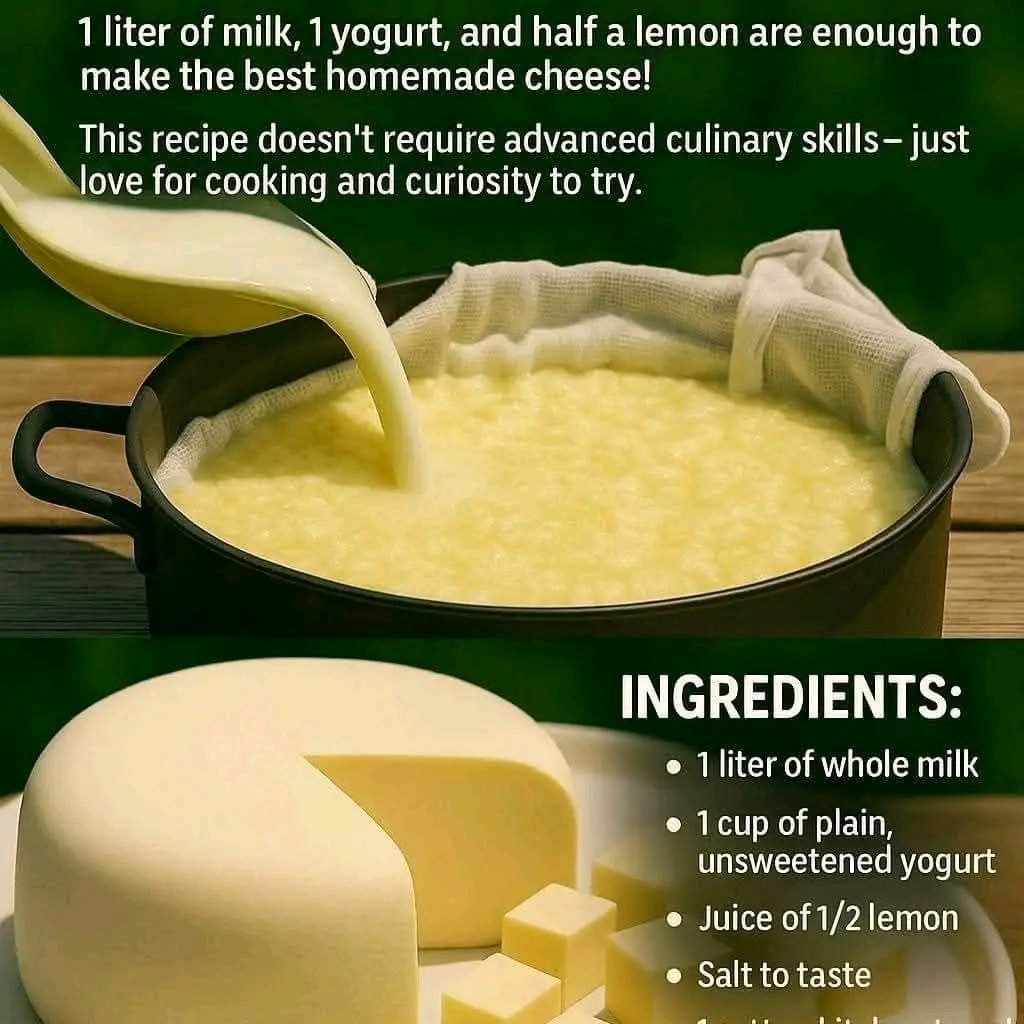Sure! Here’s a big, rich, detailed recipe for a Homemade Cheese with 3 Ingredients, including an introduction, a little history, full method, tips, lovers (cheese pairings!), and more. 🧀💛
🧀 Homemade Cheese with 3 Ingredients
A Simple, Ancient Delight — From Farmhouse to Your Kitchen
📜 Introduction: The Magic of Homemade Cheese
Cheese is one of humanity’s oldest and most beloved foods. From the mountain dairies of Switzerland to rustic Indian kitchens, cheese has captured hearts and stomachs for centuries. And believe it or not, you don’t need a fancy cheese cave or a herd of goats to make it. Just milk, acid, and salt — that’s it.
This recipe brings you back to the roots of cheesemaking — simple, nourishing, and deeply satisfying. Whether you’re a foodie, a homesteader, or just someone who wants to try something real, this 3-ingredient cheese is your entry into the world of fermented, living, beautiful food.
🧾 Ingredients (Makes about 1 cup of cheese)
- 1 liter (4 cups) of whole milk – Raw or pasteurized, but not UHT
- 2–3 tablespoons of acid – Lemon juice or white vinegar
- ½ to 1 teaspoon salt – Adjust to taste
Optional additions: herbs, garlic, cracked pepper, olive oil (for garnishing or flavoring)
🛠️ Tools You’ll Need
- Medium saucepan
- Wooden spoon
- Cheesecloth or clean kitchen towel
- Strainer or colander
- Bowl
- Thermometer (optional)
📚 A Little History of Cheese
Cheese is thought to have been discovered over 7,000 years ago when early herders stored milk in animal stomachs, causing it to curdle naturally. The curds (solids) and whey (liquid) separated, creating what we now know as cheese. From the creamy paneer of India to the aged cheddars of England, cheese has evolved into hundreds of unique forms. But it all begins the same way — with milk and acid.
🧪 The Science of Cheese Formation
When acid is added to hot milk, it destabilizes casein proteins. These proteins clump together, forming curds, while the liquid becomes whey. This process is known as coagulation. The longer and more gently you drain the curds, the creamier your cheese.
🍳 Instructions / Method
Step 1: Heat the Milk
Pour the milk into a saucepan and gently heat over medium flame. Stir occasionally to prevent scorching. Bring it to about 85–90°C (185–195°F) — just below boiling. Tiny bubbles will form at the edge.
📝 Tip: If you don’t have a thermometer, watch for the milk to steam and slightly foam.
Step 2: Add the Acid
Turn off the heat. Add your lemon juice or vinegar 1 tablespoon at a time, stirring gently after each addition. Within 1–2 minutes, you’ll see curds begin to form and separate from the watery whey.
If the milk doesn’t curdle fully, add a little more acid.
Step 3: Let It Sit
Cover the pot and let it rest for about 10 minutes to ensure full curdling.
Step 4: Strain the Curds
Line a colander with cheesecloth or a clean kitchen towel and place it over a large bowl. Pour the curdled milk into the strainer to catch the curds.
Let it drain for 10–30 minutes, depending on how soft or firm you want the cheese. The longer it drains, the firmer it gets.
Step 5: Season and Shape
Gather the cloth and gently squeeze out any remaining whey. Transfer the curds to a bowl. Add salt to taste and mix gently.
If desired, shape the cheese into a ball or press it into a container to form a block.
Step 6: Chill and Store
Refrigerate the cheese for at least 1 hour to firm up before slicing or serving.
Store in an airtight container for up to 5 days.
💞 Cheese Lovers: Serving Ideas
Pair your homemade cheese with:
- Fresh herbs like dill or chives
- Drizzles of olive oil and cracked pepper
- Warm naan or sourdough
- Honey and fruit (for a sweet contrast)
- Use in wraps, salads, or on top of pasta
- Crumbled into scrambled eggs
Whether you’re making ricotta, paneer, or a soft farmer’s cheese, this recipe is endlessly versatile and always delicious.
🧀 Types of Cheese This Can Become (Depending on Method)
| Type | Variation |
|---|---|
| Paneer | Press the cheese into a firm block |
| Ricotta | Drain for less time, keep creamy |
| Queso Blanco | Use vinegar, press lightly |
| Labneh | Use yogurt instead of milk |
❤️ Lovers of Cheese Say…
“There’s nothing like homemade cheese — you feel connected to your food.”
— Elena, home cook from Italy
“My kids love this cheese on everything. And it’s so satisfying to make!”
— James, stay-at-home dad in Canada
“This is our go-to weekend ritual. Fresh milk, a little lemon, and breakfast is transformed.”
— Priya & Nikhil, couple in Bangalore
🔚 Conclusion: Why You Should Make This
Making cheese at home is more than just cooking — it’s an act of mindfulness, of self-reliance, and of joy. With only three ingredients, you create something ancient, nourishing, and alive. It’s food with a story, and now, you’re part of it.
✅ Summary
- 🥛 1 liter milk
- 🍋 2–3 tbsp acid (lemon/vinegar)
- 🧂 Salt to taste
- 🔥 Heat, curdle, strain, season, enjoy!
Would you like a printable version of this recipe, or want me to turn it into a beautiful recipe card or PDF?
